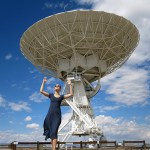Radio Astronomy
By Dr. Gerry Harp, Senior Astrophysicist, Center for SETI Research, SETI Institute, and Gail Jacobs
Trained as a quantum mechanic, Dr. Gerry Harp was deeply interested in possibilities for using the multiple telescopes of the Allen Telescope Array to generate steerable "beams" on the sky -- beams that could be far smaller than any single antenna could produce. Such beams don't emit anything, but work in reverse by capturing only energy that comes from the sky in a certain direction. Gerry joined the SETI Institute in 2000, practically at the telescope's inception and uses the telescope for…
The author, dishing.
To get to the National Radio Telescope Observatory, you have to be committed.
Well, first, you have to be in New Mexico -- about an hour's drive south of Albuquerque, in the plains of San Augustin, to be precise, a Pleistocene lakebed bordered by the northern end of the Chihuahuan Desert and dotted with arid shrubs. Despite being some 6,970 feet above sea level, it feels like the basement of the world, wide and flat and under the massive Southwestern sky. Driving to the Observatory, the home of the famous "Very Large Array" of radio telescopes, is an exercise in…
Via Jennifer Ouellette on Twitter, I ran across a Discovery News story touting a recent arxiv preprint claiming to see variation in the fine-structure constant. It's a basically OK story, but garbles a few details, so I thought it would be worth giving it the ResearchBlogging treatment, in the now-traditional Q&A format.
What did they do? The paper looks at some spectral lines in radio emission from a moderately distant galaxy with the poetic name "PKS1413+135." These lines are produced by OH molecules in interstellar gas clouds, and the frequencies they see suggest that there may have…

